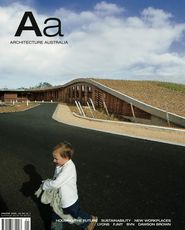ARCHITECT, PROFESSOR, RACONTEUR AND FOOTBALL FANATIC – PHILIP COX, TONY STYANT-BROWNE AND ADRIAN BADDY CELEBRATE THE LIFE AND WORK OF FRIEND AND COLLEAGE NEVILLE QUARRY.
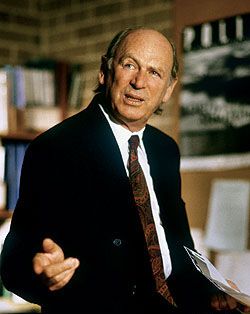
FEW ARCHITECTS HAVE the ability to give a major international address in the manner of T. S. Eliot. However, Neville Quarry did so in the speech in recognition of his Tschumi Award for the person who had contributed most to the education of architects and the furthering of its cause internationally. It was a very fitting recognition for this most important, universal man who did much to promote design and architectural excellence in this country and internally. He was a Renaissance man, being an architect, writer, critic, educator, TV presenter, family man and football fanatic.
Most of Neville’s career has been well documented in previous issues of Architecture Australia, particularly when he won the Gold Medal of the RAIA in 1994. His career path has been illustrious: from Melbourne University to Masters Degrees at Rice in the USA, a return to Melbourne University to teach, then to Lae in Papua New Guinea and finally at UTS, where he was head of school. He retired in 1994 and spent the last ten years of his life on committees and architectural juries.
The gathering of architects and friends at the Bondi Pavilion after his death was sufficient testimony to how much Neville was appreciated. Without exception, his wit, charm, easy manner, humane disposition and intellect were acclaimed.
The Neville I knew best was on the South Coast. The Quarrys jointly owned a property on the Kiah River with Sydney developer Leon Fink. It was a hideaway, a retreat from the heady business of being an academic, where he could relax with his family. Daryl Jackson and the Coxes have similar escapes on the South Coast, and during the Christmas vacation there would be social interchanges between the families.
With a glass of wine in hand and feet dangling in a running stream, it is easy to be philosophical, to say what you think, to discuss architecture and to dream of the future. It was during those times with Peg Quarry, children, grandchildren, dogs, possums and kangaroos that Neville would discuss his philosophies on the quality of life and the conservation of the environment. The very purchase of the Kiah property was a positive contribution to the preservation of South Coast landscapes. At the Bondi gathering to celebrate Neville’s life, a short video was shown by his family of Neville and Peg at Kiah. It reminded us of an Arthur Boyd painting – the still river, the gums rocketing skyward with peeling trunks and sparse canopy towards an intense cerulean blue South Coast sky.
Neville delighted in taking visitors in his runabout boat to the Kiah sandbar, where it entered the ocean. The river was relatively shallow, and Neville would have to negotiate a course, weaving from one channel to the next through water that changed from golden crystal to deep ultramarine blue. Passing mangrove stands he would relish their mystery, their tangle of structure, their roots emerging from the water as if gasping for air. Neville would grunt and point. “See over there”, he would say, “Looks like a goanna lying on the rock and over there, an oriental serpent with a Gorgon-like head … Do you think Michael Johnson paints directly from nature? … Bill Delafield Cook was staying down here and painted his best stuff”, and on he would go. The boat would chug around the next bend. A great stand of ash rising up a hundred feet, a gash of yellowing grasses entangling itself into grey-green jagged rocks. No wonder the Quarrys loved this place and found a spiritual home here.
The house at Kiah was typical of Neville and Peg. It had been there a long time. A rough happening of weatherboards, a verandah slightly perilously attached to the house facing away from the river, a kitchen confused with wash-ups of the last banquet of fish and oysters, the empties stacked on the floor near the fridge. The bedrooms were small and cosy, with a litter of guests all patter-caked into a couple of pavilions loosely connected by a lean-to covering ›› It was not an architectural statement. There was no need to sit in awe and wonder an feel that one was to experience multiple orgasmic spatial and architectural happening. It was like Neville and Peg – simple, direct, homely, human and welcoming. The bedrooms did, however, manage to face the river, where the upstream sweep could be viewed for some distance, and the same could be said of the loo, which also commanded one of the best views. Apart from that, the house could have been a candidate for Rude Timber Buildings, but even then it may not have made the settler’s hut grade.
I had often thought that the verandah was deliberately facing Leon’s arboretum – strange collection of eucalypts planted in orchard formation in a deliberate attempt to formalize and tame nature – where all could admire the tenacity of botanic endurance, rather than any aesthetic landscape consideration. I don’t think that Neville or Peg were gardeners. They admired gardens, they just did not have the urge to dig. They admired and smiled at the abundance of nature.
Neville and Peg would gather around them people from all walks of life, painters, sculptors, writers, architects, developers, judges and people who had no pretension, who, like the Quarrys, had quality of life ›› There will be a great hole left by Neville’s passing.We can rejoice in his good works, his writing, his architecture and the many students who will always hold Neville as one of the most important influences of their lives.
PHILIP COX WAS A FRIEND OF NEVILLE QUARRY, A COLLEAGUE AND A FELLOW ARCHITECT.
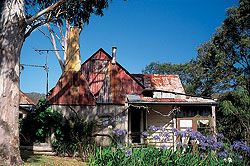
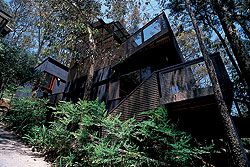
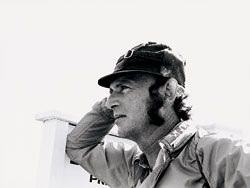
“i think of myself as deeply superficial”
“I would have written a shorter piece but didn’t have the time”
“If a job’s worth doing it’s worth doing badly”
You have every right to be wrong [on Federation Square].”
›› THESE ARE JUST a few Quarry paradoxes – Neville Quarry’s way of deftly an diplomatically forcing his students and colleagues to question their view of the world, to look at things with fresh eyes. This wonderful mind, active to the last, was extinguished on Thursday 28 October 2004 and many communities will mourn its loss.
As a young lecturer at the University of Melbourne in the early sixties, fresh from graduate school at Rice, Quarry, as Second Year Design Master, offered a course that was a perfect complement to Hugh O’Neill’s traditional Bauhaus basic First Year Design studio. He encouraged us to approach design problems from first principles, employing such programmatic vehicles as a minimum habitat for a single occupant; a vertical ordering of domestic spaces, 1/level; and an Appliance House (borrowed from the Smithsons) where food preparation and ablutions were liberated from their traditional fixed locations. Quarry’s time at Rice exposed him to the American model of the architectural academy, where teachers also practised, and he made the most of the limited opportunities in Melbourne, building a fine, spare neo-Brutalist house in Kew for his rapidly expanding family.
He sold this in 1970 to a colleague, Blanche Mertz, and, taking a considerable risk, became the first Head of the School of Architecture at the Papua New Guinea Institute (now University) of Technology in Lae. There, on a broader canvas, Quarry applied his unique analytic, synthetic and political skills to pedagogy, practice and national development.
His significant achievements in PNG included the first two indigenous graduates in 1974 several fine buildings on campus – student residences, a new building for the School of Architecture and his beautiful, clever Christian Centre; active participation in academic governance as the Deputy Vice Chancellor; and his innovative yet commonsense contributions to the numerous Boards and committees on which he sat, preparing the country for its postcolonial phase. As Head of School he led a disparate (and, to the conservative university administration, raffish) group of teachers, but managed to impart to it a strong sense of common purpose. Ever egalitarian, he was one of the few senior academics on campus who socialized with the students. The number of Nevilles born in Lae in the seventies is testament to his popularity among them.
During a short stint as Visiting Professor at UCLA and SCIARC in the late seventies, Quarry explored Southern California, seeking out its hidden architectural treasures, and treated the local faculty and students to his particular brand of Ozcratic dialogue, to the bemusement of some and the delight of others.
Neville Quarry touched many lives within and without the field of architecture but his mission was nowhere near complete. As he expanded his practice after retirement and delved into such arcane topics as the architecture of the Annunciation and the villas of Pliny, he was taken way too early.We are left poorer for his death.
TONY STYANT-BROWNE WAS AN UNDERGRADUATE STUDENT OF NEVILLE QUARRY’S, A COLLEAGUE IN PNG, A HOUSEMATE IN LOS ANGELES AND A FRIEND.
EACH OF OUR LIVES is shaped by a myriad of influences. For me, Neville David Quarry towers larger than most. I am but one of many, from all walks of life, fortunate to have known him. Neville was multifaceted: a charismatic educator and author; architect; husband of Peg, and Penny, Kit, Tim and Bill’s dad; advocate of social justice; “true believer”; Aussie Rules fanatic; humorous raconteur; debater; television personality; party animal and dancer; tireless traveller … to list but a few of his interess.
I first encountered Neville in 1965 at the University of Melbourne’s School of Architecture, where he appeared “seriously cool”. His articulate insights into the world of contemporary architecture transfixed us. Little did I realize that here, in my very first year of study, was the person I’d work alongside for 33 years. In 1971 Neville Quarry was appointed inaugural Professor of Architecture in the Papua New Guinea School of Architecture at Lae – he was just 37. Somehow I convinced him that I was “right” for the new school’s senior tutoring position. The rest, as they say, is history. Neville initiated unique educational programmes, including village studies and design-construct projects that were important to local communities and student learning. Preconceptions and conventions were challenged; his young staff, including Gordon Holden, Janet Grey, Tony Styant-Browne, Malcolm Horner and Ken Costigan, were cohesive and energizing. Neville generously gave us latitude to develop our professional abilities - and as a consequence we all progressed to other successful careers ›› At various times he and I travelled together through the South Pacific, South-East Asia, China and Europe.We must have taken tens of thousands of architectural photographs, but we didn’t photograph ourselves. Consequently I have very few portraits of Neville. This particular one, however, was taken in January 1974 in the People’s Republic of China.We’d spent the previous two weeks in sub-zero conditions in and around Beijing, and the more moderate social and climatic conditions of Hong Kong were beckoning. Mutton chops are a clue to the era and Neville is contemplative as he patiently waits on a platform at Canton’s railway station. Perhaps he’s reflecting on the austerity of rural communes, or the grand axiality of the Forbidden City; perhaps he just can’t wait to be home with the family again?
Much has taken place during the intervening years, including working alongside Neville at NSWIT and UTS. Perhaps most notably he was the recipient of the RAIA’s Gold Medal and the UIA’s Jean Tschumi Award for his contributions to architectural education.
I might conclude this short acknowledgment of Neville Quarry’s life with a memory from just a few months ago. The Swans were playing the Bombers at Homebush and I was to meet Peg and Nev outside the stadium. While waiting, I wandered round to the totemic memorial for the Sydney 2000 Olympic Volunteers, an exciting piece of design linking Homebush Station and the main stadium (authored by graduate, colleague and mutual friend Tony Caro). Inscribed in 10 mm lettering is the name Neville Quarry. Here is a most appropriate reminder of our friend: accomplished, modest and surrounded by the names of thousands of others who donate their talent and energy to maintain Australia’s values of social equity and achievement.
A truly great game Nev, and for once I’ll resist saying “car’n the Bombers”!
ADRIAN BODDY IS AN ASSOCIATE IN THE FACULTY OF DESIGN ARCHITECTURE AND BUILDING UTS, AND A FREELANCE ARCHITECTURAL PHOTOGRAPHER.

